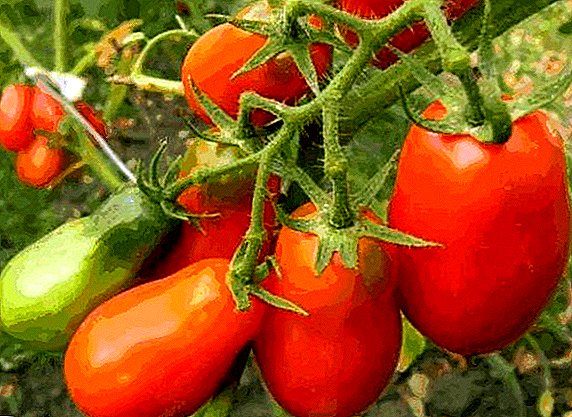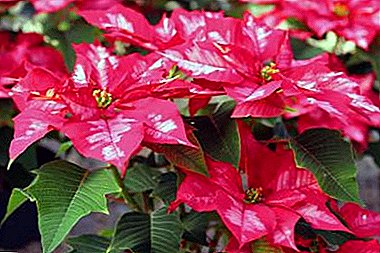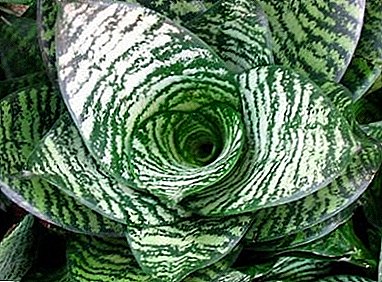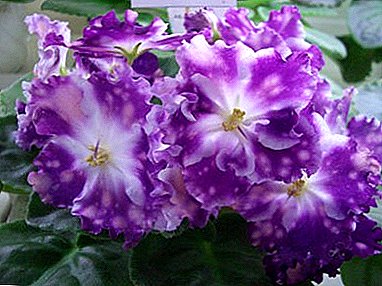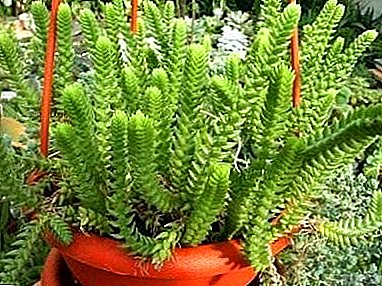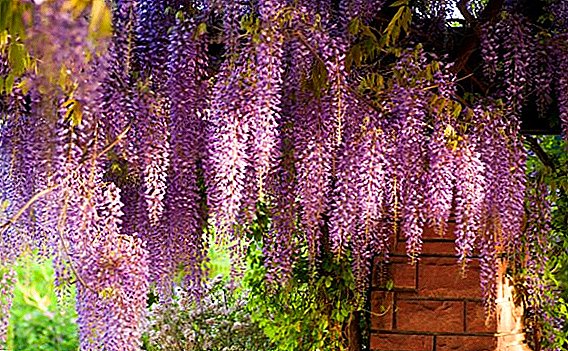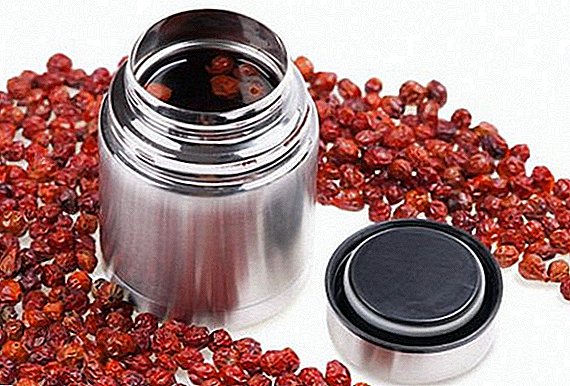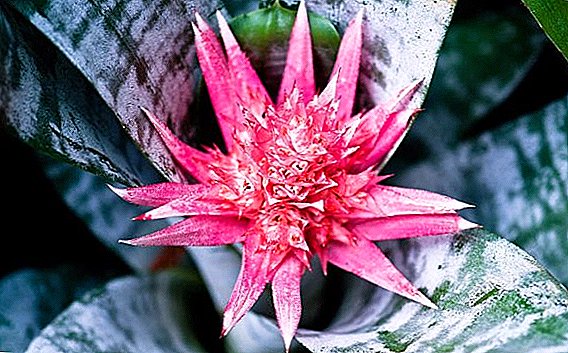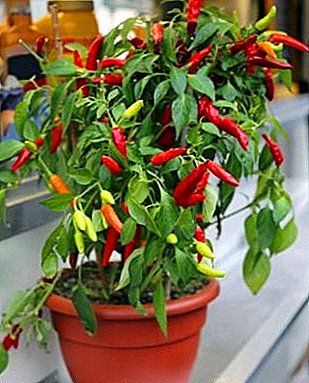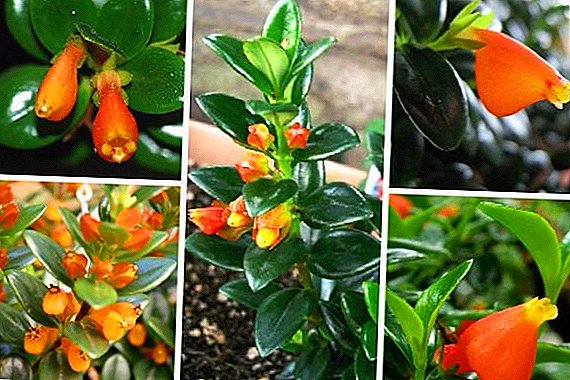 Flower nematantus is a member of the Gesneriev family. The plant got its name thanks to the scientist Heinrich von Schroeder. The neologism "nematantus" means a flower on a thin peduncle. In modern agro-society, there is another name for this beauty - “golden fish”.
Flower nematantus is a member of the Gesneriev family. The plant got its name thanks to the scientist Heinrich von Schroeder. The neologism "nematantus" means a flower on a thin peduncle. In modern agro-society, there is another name for this beauty - “golden fish”.
Description
The native land of the nematantus is tropical Brazilian forests. Its leaves are elliptical, drooping down. Aerial roots develop in the leaf axils.  The stems of a goldfish are erect, although with the growth of the plant they begin to bend. The shape of the flowers is tubular, with a pocket-shaped corolla, and their length reaches 5 cm. Sometimes the corolus is red, and sometimes it is colored orange. Less often, but still there are instances of pink and lilac color. The flowering of nematantus occurs from spring to autumn.
The stems of a goldfish are erect, although with the growth of the plant they begin to bend. The shape of the flowers is tubular, with a pocket-shaped corolla, and their length reaches 5 cm. Sometimes the corolus is red, and sometimes it is colored orange. Less often, but still there are instances of pink and lilac color. The flowering of nematantus occurs from spring to autumn.
Potted flowers can be not only a great addition to the design, but also beneficial to human health. Among them are: chlorophytum, aloe, geranium, laurel, ficus, Kalanchoe, chrysanthemums, cactus, pelargonium, sansevieria.
Landing
The most convenient soil for rooting "goldfish" is a loose peat substrate along with water. In order for the flower to take root in this consistency, cuttings should be put into the greenhouse with a temperature of 23-24 degrees maintained in it.
The first roots will grow in 2-3 weeks, after which the cuttings are transplanted into different pots. The soil mixture should be light and loose, the air should circulate freely. 
Important! To prepare the soil for "golden fish" It should mix the leaf soil and peat in a ratio of 1: 1, add a mixture of sand and humus. Vermiculite is added at the end.The "goldfish" is planted in a tank in which a drainage layer is placed under the substrate. The plant should be transplanted every year up to the age of four, and then every two years. All further movements of the flower are made in a new larger pot.
Breeding
Flower reproduction "goldfish" occurs through seed and vegetative methods (using stems and upper cuttings).
Seeds
Small seeds of "goldfish" are placed on a sheet of paper and, holding the sheet with your fingers, make the seeds on the moistened soil in a container with holes. After sowing, cover the container with glass and place it on a pallet.
After sowing, cover the container with glass and place it on a pallet.
It is with the help of the latter that it is possible to produce further watering of the plant. At emergence of the first shoots it is necessary to air capacity. After the seeds germinate, you need to dive in separate pots for several pieces. Next year the plant will bloom.
Cuttings
The most convenient and favorable method of breeding a goldfish is the vegetative method. This requires cuttings that are up to 10 cm in length. Cuttings are cut from over-ripe shoots, as young shoots contribute to rotting. 
Important! It is necessary to plant the cuttings so that the knot is embedded in the ground, since it is he who creates easily growing aerial roots.
Care
A hypocirta does not need special care, and if you follow certain recommendations, you can avoid many potential problems.
Conditions
To take care of a hypothyroid at home, there are several main aspects to consider. So, for good breeding the flower should be grown in a lighted place. However, avoid exposure to the sun, which can injure and dry the plant. The best option would be to put a flower on the window sill, which goes to the east side of the house.  In the event that the windows are facing south, it is necessary to prepare in advance the protection from the sun’s rays at noon.
In the event that the windows are facing south, it is necessary to prepare in advance the protection from the sun’s rays at noon.
The most comfortable temperature for growing this plant is 22-25 degrees. If the temperature is higher than this, the plant begins to dry out and suffers. Nematantus loses its beauty at low temperatures.
On average, air humidity should be kept at 50%. An increase in air temperature should be directly proportional to the increase in its humidity. This can be achieved with a spray bottle that sprays air around the flower. Do not over-moisturize the flower, as this contributes to the fall of the foliage. 
Watering
When caring for the flower should be followed by moderate watering. It is necessary to use separated water, the temperature of which will not exceed 25 degrees.
Did you know? The largest flower in the world is Rafflesia Arnold. Its weight reaches 11 kg, and the diameter of the plant is 92 cm.
In the event that the plant suffers from insufficient moisture, small leaves will fall off, and large ones will curl. Drying the soil contributes to the drying of the flower. If the soil is very dry, you should put the pot in a container with water, provided that the water will not overflow the edge of the pot with a flower. 
Top dressing
"Golden fish" requires the introduction of certain fertilizers during the active phase of reproduction. At home for the flower is considered the most acceptable complex mineral fertilization, which is introduced into the ground several times within two weeks. Such care will allow to preserve the nutrient soil for a long period.
In the case of using concentrated liquid fertilizers, they need to be diluted with water. Fertilizers should be applied in the evening so that they do not fall into the sun. Before feeding you need to moisten the soil. 
Pruning
For stable cultivation of "goldfish" you need to remember to cut the flower. This procedure is performed in the autumn, before the plant goes on a well-deserved rest. If the flower is in the winter time to be in a warm room, you should move the trimming of nematantus in the spring. When pruning need to remove all thin and weak shoots.
Transfer
Flower transplantation should take place in larger pots. In the event that the nematantus is already elderly, it should only be re-abraded and not transplanted. In one large pot fit several cuttings. Do not forget to make a drainage layer that allows you to extract all the unnecessary water. 
Diseases and pests
Nematantus, which is grown at home, is quite resistant to parasites and diseases. However, sometimes the aphid or mite can harm this flower. The most common cases of disease are plants because of poor care.
Did you know? Several centuries ago there was a science about the meaning of flowers - villages. Inspired by this science, the Russian poet Dmitry Oznobishin wrote the book Selam, or the Language of Flowers, which says that each flower has a certain symbolic meaning and a certain replica in a conversation in flower language.
Another pest is a mealybug, which climbs into the leaf axils. The presence of this pest is characterized by vat-like secretions. You can eradicate this disease with the help of alcohol.  Aphids and mites are very harmful insects for the nematantus. This is due to the fact that these pests pull out the juice from the flower and instantly subject it to viral diseases that are not treatable. By treating the plant with the help of "Akarina" or "Fitoverma", you can get rid of these parasites.
Aphids and mites are very harmful insects for the nematantus. This is due to the fact that these pests pull out the juice from the flower and instantly subject it to viral diseases that are not treatable. By treating the plant with the help of "Akarina" or "Fitoverma", you can get rid of these parasites.
In the event that the "goldfish" is contained in greenhouse conditions with low air circulation, the flower is very often exposed to fungal diseases. If a nematanthus has undergone a disease, it must be treated with fungicidal agents.
Possible difficulties
Quite often, growers complain that the nematantus does not bloom. The reason for this problem is quite simple - many do not know how to properly care for the flower. In the event that the plant does not bloom for a long time, it should be transplanted into another pot, taking into account all the above recommendations. So, care for the soil should be carried out in accordance with the necessary agricultural technology, the size of the pot should be small so that the earth fits snugly to it. Scattered, but bright enough lighting will also bear fruit. Stable watering increases the chances of a quick flowering.
Observing all the recommendations and adhering to a certain algorithm for the care of the "goldfish", you can achieve a positive result in the cultivation of this flower. Do not forget that the plant needs a winter rest, in which the room should be cool, with normal lighting, but without fertilizer and watering.


